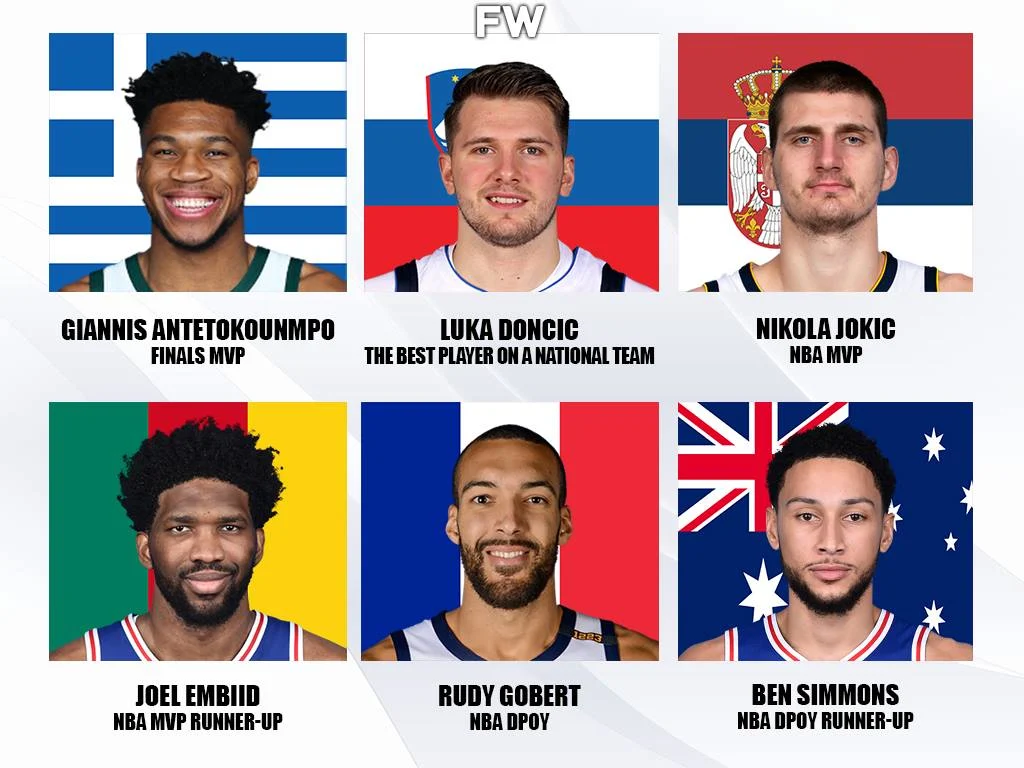SideshowBob wrote: Garnett's offense can be broken down like this:
-Spacing
-PnR (Roll/Pop)
-High-Post
-Low-Post
-Mid-Post
-Screens
Remember, there is overlap between these offensive skills/features; I'm trying to give a broad-strokes perspective here.
Let's talk about his shooting really quick, and then dive in. What I want to consider is how and which of these traits show up in the box-score, as well as which would be resilient in the face of smarter defenses.
-Has range out to the 3 pt line but practically/effectively speaking, he's going out to ~22 feet.
-From 10-23 feet, shot 47.7% in 03 (9.6 FGA/G), 45.2% in 04 (11.0 FGA/G), 44.6% in 05 (8.3 FGA/G), 48.4% in 06 (8.4 FGA/G)
-16-23 ft range, he's assisted on ~77% over those 4 years
-Shooting at the big-man positions is a conundrum - shooting 4/5s are often associated with weak (breakeven) or bad (negative) defense. Garnett is one of the few exceptions in that not only is he an elite shooter, there's virtually no defensive opportunity cost to playing him over anyone in history.
------------------------------------------------------------------------------------------------------------------------------
When he's on the ball, he can utilize his exceptional ball-handling skills to create separation and knock it down. When he's off the ball, he's always a threat to convert - the fact that he's assisted so frequently on 16-23 ft shots means they're mostly coming on a Pick and Pop or a drive and kick, which means a lot of them are open. He's usually shooting around 45% overall from there, so we're looking at high 40s on open shots and low-mid 40s on created ones. BOTH of those numbers are strong, and that's where the first offensive trait comes;
Spacing. His shooting spaces the floor. A LOT - despite the fact that he doesn't shoot 3s, he forces bigs out of the paint and opens up the lane. Because he's not a 3-point shooter though, this effect doesn't really show up in the box-score. And yet, this effect will always be present; doesn't matter how much a defense slows down his raw production in the playoffs, the spacing effect will always be present - he's going to try and create shots from out there and he's going to pop/spot-up; give him space/leave him open and he'll convert at .95-1.00 PPP (which is very strong in the halfcourt). Cover him/recover on him with a little guy and he'll just shoot right over. His man
has to come out and try and cover him, and this means that there will always be a marginal improvement for the rest of the team with regards to the lane being open. The only real way to reduce this? Have someone at the 1-3 that can cover him (has the size/strength to cope with his shot/inside game for stretches at a time), but even then, you might yield a disadvantage with one of your bigs covering a small ball-handler.
So next, his
PnR game. Crucially, he's a dual threat, he's deadly popping out (as demonstrated above) but even crazier rolling to the basket (high 60s-70ish finishing, that includes post/isolation, thus baskets on the roll would likely be higher. The rolls are similar (though not equal) to drives to the basket and aside from finishing offer an opportunity to kick it out. THIS aspect is captured fairly well by the box-score (rolls into finishes - FG%, finishes - PTS, kick outs - direct assists). This is also one that good PnR defense teams can slow down. Close off the PnR by stopping the ball handler (aggressive blitz/trap to force the ball out their hands before the PnR is initiated, or drop center, ice sideline to deny the ball-handler middle), or rely on strong rotations into the lane to close off easy baskets off a roll. When we talk about his postseason dips (mainly PPG and TS%), this is mostly where they're coming from (and face up game which I'll get to later).
So now, the post options. The
high post probably yields the largest fraction of his offensive impact. His scoring skills (again, ball-handling to set up midrange game, quickness/explosion to attack the basket straight on, catch&shoot/spotup, etc.) means that he draws a great amount of attention here, again, pulling a big away from the restricted area and up to the free throw line. This is significant because he can spot and capitalize on any off ball movement, use his passing to force rotations until an opportunity is created, play the give and go with a small. Essentially, there are a ton of options available here due to his gravity and diversity, yet almost
none of this will show up in the box-score. Unless he hits a cutter with a wide open lane or a shooter with a wide open corner, he's not going to be credited with the assist.
Imagine - he sucks/turns the attention of the defense to himself, a cutter sees an opening and zips in from the wing, which forces a defender from the corner to come over and protect the basket, leaving a shooter open. Garnett hits the cutter who dishes it out, or he kicks the ball out to the perimeter and it is swung around to the open shooter. Garnett's pressure created the opening, and his passing/vision got the ball where it needed to go, but he's given no credit in the box-score.
Give and go is another example - at the top of the key, he gets the ball, his man (a big) is now worried about his shot and starts to close in, the lane has one less protector, the PG who just threw it in to him now curls around him with a quick handoff,
his defender now runs into Garnett or his man and the PG gets an open lane to the basket. If someone has rotated over, a shooter will be open, if not, free layup for the PG, or a kick out for a reset for Garnett in the high/mid-block area. IF it works out that the PG gets an opening up top on the handoff, then he may get a pullup and Garnett is credited with an assist, but in most scenarios, it will play out that again, Garnett gets no box-score credit.
The effect of this play on the offense
is resilient, its going to remain present against strong defenses. It doesn't matter how strong your rotations are or what kind of personnel you have, the key is that adjustments have to be made to combat a talented high-post hub, and when adjustments are made, there is always a cost (which means the defense must yield
somewhere) and therein lies the impact. This is one of the most defense-resistant AND portable offensive skillsets that one can have (you're almost never going to have issue with fit) and its what made Garnett, Walton, 67 Chamberlain, so valuable.
Mid-Post and face-up game are a little more visible in the box-score (similar to PnR). Mostly comprised of either blowing by the defender and making quick moves to the basket (and draw a foul) or setting up the close-mid-range shot. This is his isolation offense, something that will tend to suffer against stronger, well equipped defenses that can close off the lane, which sort of strips away the "attack the basket, draw free throws" part and reduces it to just set up mid-range jumpshots. Garnett's obviously great at these, but taking away the higher-percentage inside shots will hurt his shooting numbers, volume, and FTA bit. The key then is, how disciplined is the defense. Yes they can close the paint off, but can they do so without yielding too much somewhere else - was there a missed rotation/help when someone left his man to help cover the paint. If yes, then there is impact, as there is anytime opportunities are created, if no then its unlikely any opportunity was created and the best option becomes to just shoot a jumper. This is the other feature of his game that isn't as resilient in the face of smart defenses.
The
low-post game is crucial because it provides both a spacing effect and the additional value of his scoring. While he lacks the upper body strength to consistently finish inside against larger bigs, he can always just shoot over them at a reliable % instead, and against most matchups he's skilled enough back-to-basket and face-up that he can typically get to the rim and score. Being able to do this means that he draws attention/doubles, and he's one of the best at his position ever at capitalizing by passing out to an open shooter or kicking it out to swing the ball around the perimeter to the open guy (in case the double comes from the opposite corner/baseline) and all of this action tends force rotations enough that you can get some seams for cuts as well. Outside of scoring or making a direct pass to the open guy, the hockey assists won't show up in the box-score. But, more importantly, there is a crucial utility in having a guy diverse enough that he can play inside and out equally effectively - lineup diversity. He fills so many staples of an offense himself that it allows the team to run more specialized lineups/personnel that might not conventionally work, and this forces defenses to adjust (! that's a key word here). He doesn't have to do anything here that shows up in the box-score, all he needs to do is be on the floor. You can argue the low-post ability as a 50/50 box-score/non-box-score, but I'd lean towards giving the latter more weight.
Finally
screens. The effect of Garnett's screens is elite, because of his strong lower body base and because of the diversity of his offensive threat (and he just doesn't get called for moving screens). Its tough for most players to go through/over a Garnett screen, which makes him ideal for setting up jumpers and cutters off the ball. When he's screening on the ball, everyone involved has to worry about his dual scoring threat, and when that happens, that gives the ball-handler
that much more space to work with. Marginal on a single possession, significant when added up over the course of ~75 possessions, and extremely resilient - how do you stop good screens? You don't really, you just stay as disciplined as possible. And this effect is completely absent in the box-score.
So what's important now is to consider the fact that
most of Garnett's offense does not show up in the box-score! And I wouldn't call what he does on the floor the "little things" (this is just something people have been conditioned to say, most things that aren't covered in the box-score have become atypical/unconventional or associated with grit/hustle, despite the fact that these are pretty fundamental basketball actions/skills).
Something like 75-80% of his offensive value just simply isn't tracked by "conventional" recordkeeping, yet the focus with Garnett is almost always on the dip in scoring and efficiency. So what if the 20% that
is tracked has fallen off. Even if that aspect of his game fell off by 50% (it hasn't), the rest of his game is so fundamentally resilient that I'm not even sure what degree of defense it would take to neutralize it (at least to an effective degree, I'm welcome to explanations), and that still puts him at 80-90% of his max offensive impact (given the increased loads he was typically carrying in the playoffs, I doubt it even went that low). The generalized argument against him of course tends to be "where are the results", and quite frankly it needs to be hammered home that his Minnesota casts were
actually that bad. Not mid 2000s Kobe/Lebron bad, like REALLY bad, like worst of any top 10 player bad.

























